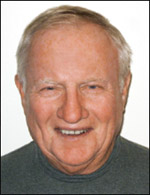 Growing up in the southwestern corner of Virginia in the ’40s and ’50s, I assumed that listening to Flatt & Scruggs and the Carter Family on WCYB in Bristol, VA was a common experience for everyone. I was unaware at the time that this unique music had its roots in our part of the country. My mother had told us about the pre-Grand Ole Opry “Uncle Dave Macon” visiting her family’s farm near Nashville in his horse drawn buggy, and about later living in Bristol, TN across the street from a teenaged “Ernie Ford,” who would sit on his front porch steps and serenade anyone passing by.
Growing up in the southwestern corner of Virginia in the ’40s and ’50s, I assumed that listening to Flatt & Scruggs and the Carter Family on WCYB in Bristol, VA was a common experience for everyone. I was unaware at the time that this unique music had its roots in our part of the country. My mother had told us about the pre-Grand Ole Opry “Uncle Dave Macon” visiting her family’s farm near Nashville in his horse drawn buggy, and about later living in Bristol, TN across the street from a teenaged “Ernie Ford,” who would sit on his front porch steps and serenade anyone passing by.I thought bluegrass was a bit too rustic then, but enjoyed Hank Williams, Ernest Tubb and similar artists because their music was melodic and often included my favorite instrument, a steel guitar. By 16, I had begun to listen to a different kind of music, also coming from Nashville via the far-reaching WLAC-AM, that featured R&B artists such as Muddy Waters and rock ‘n’ roll artists such as Little Richard. During college, I enjoyed rock ‘n’ roll publicly and country privately, since country was not particularly cool. Later, serving in the Marines, the music playing in the Quantico officers club was invariably Baroque—mostly Bach and Vivaldi—and I began to enjoy it also. While earning a Ph.D., I continued to explore many types of music including gospel, Mariachi, and Cajun, among others. Despite being mentored by and publishing with future (2002) Nobel Laureate Daniel Kahneman, I was disappointed that family members were basically disinterested in the scientific articles and book chapters I wrote about the psychophysiology of mental activity. I was never really sure whether it was my particular area of research or my particular family and some 30 years later I am still not certain. Perhaps an attempt to measure the mental activity, or lack thereof, of my family would have been more relevant. But I digress.
While working at Bell Laboratories in New Jersey, I could go to Lincoln Center or Carnegie Hall one week and to The Lone Star Café or The Bottom Line the next. At a sold-out performance of Poco, I felt the thrill of hearing the incredibly tight harmonies on their “Sweet Lovin’” punctuated by Rusty Young’s pedal steel, and thinking how amazing a live musical experience can be. After relocating to northern California, I found a wide spectrum of live music, ranging from the San Francisco Symphony at Davies Hall to Big Lou’s Polka Casserole at The Freight & Salvage to Red Meat’s high cholesterol honky-tonk at The Great American Music Hall to Foxtail Somersault’s ethereal sounds at The Makeout Room.
More recently, I had relatives listen to the harmonies of The Louvin Brothers as a prelude to appreciating the complexity of the counter harmony in the Barcarolle from Offenbach’s “ Tales of Hoffman.” The reaction to the classical piece was groaning accompanied by rolling eyes and gagging motions. While I was not totally surprised by their response, it did cause me to once again ponder the issue of genetic inflexibility. On the other hand, after I started to write about music for Elmore, family members who had shown no interest in my previous writings began to ask about my music reviews and related activities—providing yet another instance of the universality of music as a source of common language and shared interest among us all.
—Scott Peavler



Be the first to comment!